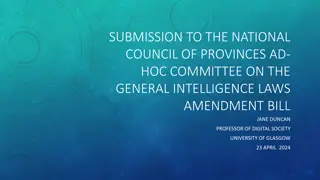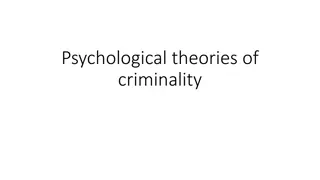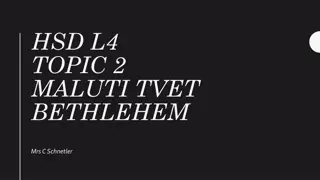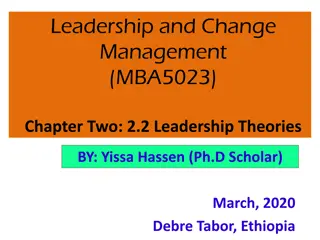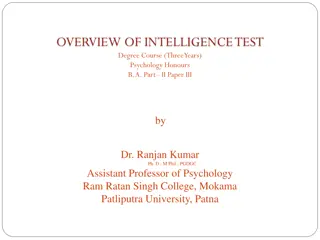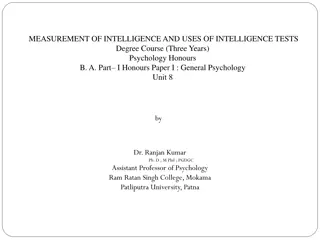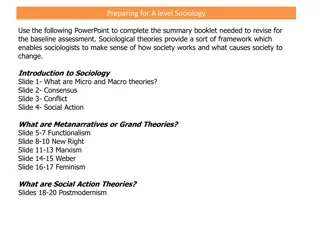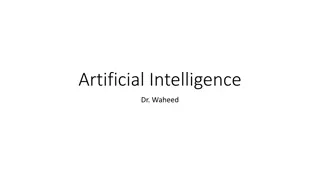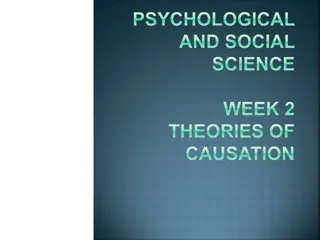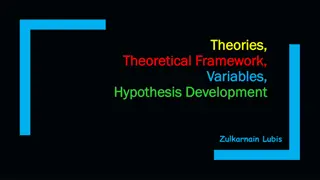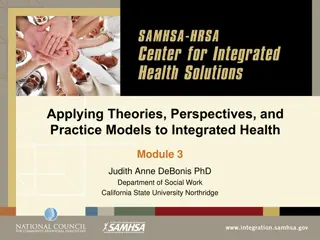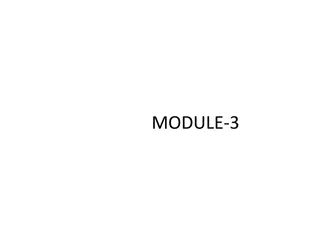Insights into Theories and Definitions of Intelligence
Various psychologists throughout history have defined intelligence in different ways, highlighting aspects such as judgment, reasoning, adaptation, problem-solving, and overall mental capacity. From Binet to Gardner, each perspective sheds light on the diverse facets of intelligence, emphasizing the ability to adapt, solve problems, and act purposefully in different environments. Charles Spearman's Two-factor theory delves into the concept of general intelligence (g-factor) and specific intelligence (s-factor), showcasing the complexity of intellectual tasks. Understanding these diverse viewpoints provides a comprehensive insight into the multidimensional nature of intelligence.
Download Presentation

Please find below an Image/Link to download the presentation.
The content on the website is provided AS IS for your information and personal use only. It may not be sold, licensed, or shared on other websites without obtaining consent from the author.If you encounter any issues during the download, it is possible that the publisher has removed the file from their server.
You are allowed to download the files provided on this website for personal or commercial use, subject to the condition that they are used lawfully. All files are the property of their respective owners.
The content on the website is provided AS IS for your information and personal use only. It may not be sold, licensed, or shared on other websites without obtaining consent from the author.
E N D
Presentation Transcript
Defining intelligence Binet (1916) defined it as the capacity to judge well, to reason well, and to comprehend well. Terman (1916) defined it as the capacity to form concepts and grasp their significance. Pintner (1921) defined it as the ability of an individual toadapt well to new situations in life
Thorndike (1921)defined it as the power of good responses from the point of view of truth or fact Thurstone (1921) defined it as the capacity to inhibit instinctive response, imagine a different response, and realize the response modification into behavior Spearman (1923) defined it as a general ability involving mainly the ability to see relations and correlates
Defining intelligence Piaget (1972) defined it as referring to the superior forms of organization or equilibrium of cognitive structuring used for adaptation to the to the physical and social environment Sternberg (1985) defined it as the mental capacity to automatize information processing and to emit contextually appropriate behavior in response to novelty Gardner (1986) defined it as the ability to solve problems or fashion products valued within some setting
Wechlser (1939)defined it as the aggregate or global capacity of an individual to act purposefully, think rationally, and deal effectively with the environment
Definition Aggregate and Global implies it is revealed by an individual behaviour as a whole. Purposeful implies that intelligent behaviour is goal directed which is based on drives and incentives.
Charles Spearman Two factor theory His hypothesis is all intellectual tasks must entail the exercise of a factor known as general intelligence(g factor) In examining correlation of various subsets of intelligence, he found that certain subsets tend to correlate higher than others Each individual type of item requiring "specific factor" called "S" factor.
Two Factor Theory An individual has overall supply of mental energy and the "S" factor is invoked for specific purpose as neurological engine. He thought that itcan be represented by a single number.
LouisThrustone He contributed that Spearman s g factor consists of seven sub factors ( Primary mentalabilities) Verbal comprehension word fluency Numerical ability spatial Visualization associative memory perceptual speed Inductive reasoning
Cattell & Horne Fluid Intelligence characterized by Biological factors capacity to learn new ways of solving problems and performing activities Decreases with age Crystallized Intelligence More characterized by environment accumulated knowledge of the world we have acquired throughout our lives increases with age
Robert Sternberg's Triarchic Theory Analyticalintelligence Basic information processingskills Creativeintelligence Ability to deal with novel versus routine problems Practicalintelligence Ability to adapt to different contexts, and to select and shapecontexts
Howard Gardners Theory of Multiple Intelligences Gardner (1983, 1999) supports Thurstone s idea that intelligence comes in multiple forms. Gardner noted that brain damage may diminish one type of ability but not others e.g.,savants.
Howard Gardners Theory of Multiple Intelligences 8 types ofintelligence speculates about a 9th existential intelligence" = ability to think about the question of life, death and existence.
Intelligence Description Linguistic The ability to speak and write well Logico-mathematical The ability to use logic and mathematical skills to solve problems Spatial The ability to think and reason about objects in three dimensions Musical The ability to perform and enjoy music Kinesthetic (body The ability to move the body in sports, dance, or other physical activities Interpersonal The ability to understand and interact effectively with others Intrapersonal The ability to have insight into the self
Howard Gardners Theory of Multiple Intelligences
Principles of Test Construction 18 For a psychological test to be acceptable it must fulfill the following three criteria: 1. 2. 3. Standardization Reliability Validity
Standardization 19 The standardization of a test involves giving it to a large number of people at different ages and computing the average score on the test at each age level. important that intelligence tests be standardized on a regular basis FLYNN EFFECT - In the past 60 years, intelligence scores have risen steadily by an average of 27 points.
NormalCurve 21 Standardized tests establish a normal distribution of scores on a tested population in a bell-shaped pattern called the normalcurve.
Reliability 22 A test is reliable when it yields consistent results. To establish reliability researchers establish different procedures: 1. Split-half Reliability: Dividing the test into two equal halves and assessing how consistent the scoresare. Test-Retest Reliability: Using the same test on two occasions to measure consistency. 2.
Validity 23 Validity of a test refers to what the test is supposed to measure or predict that they actually measure intelligence rather than something else
History of Intelligence Testing Head Circumference (Francis Galton 1880) first attempts to measure intelligence Binet-Simon (Alfred Binet 1909) first intelligence test comissioned by French gov to separate children into vocational vs academic schooling did not design test to measure intelligence created concept of mental age (MA) 1. 2.
30 items of increasing difficulty - 1905 Revision 1908 age specific versions These were developed to identify children who needed special education - Binet believed that IQ could be increased by education
Stanford-Binet Intelligence Scale Lewis Terman (1916-72) first U.S. intelligence test Interested in gifted children translated and modified Binet s scale Heavy reliance on vocabulary/language skills incorporated old items from the Binet scale, plus some new items poorly standardized on 1000 children and 400 adults who were not selected with care 3.
Developed Intelligence Quotient IQ = (MA/CA)*100 MA= Mental Age; CA = ChronologicalAge
1916 Stanford-Binet Sample Items for 12 yr olds Practical Problem Solving Vocabulary Grammar 1. 45. Sportive. 80. Exaltation. 92. Theosophy Orange. FOR THE STARTED AN WE COUNTRY EARLY ATHOUR TO ASKED PAPER MY TEACHER CORRECT I MY A DEFENDS DOGGOOD HIS BRAVELY MASTER Interpretation Similarities Memory Snake, cow, sparrow 3-1-8-7-9 Book, teacher, newspaper Wool, cotton, leather 6-9-4-8-2 5-2-9-6-1
Currently in its 5thedition Assesses intelligence and cognitive abilities in children and adults aged 2- 23 yrs Total testing time 45-90 minutes Hindi adaptation Santhosh Kumar Kulshetertha
Binet Kamath Intelligence Scale Kamath undertook a revision of the Stanford Binet Scales to suit Indian conditions. The test has subtests from Age III to XXII. For each item passed the child earns a credit of 2 months, 4 months or 6 months depending on the corresponding age. IQ = MentalAge 100 ChronologicalAge The IQ thus obtained is classified.
Weschler Intelligence Scale (David Weschler, 1939-81) designed to show subtest scores Less reliant on language/vocabulary skills Contains Verbal and Performance subtests Performance compared to same age peers raw score has different interpretation depending on age Designed widely used test for adults (WAIS), children (WISC), and preschoolers (WPPSI) Indian adaptation WAPIS Prabha R
WAPIS-R Testing kit Testing Booklet Puzzle Pieces Story Cards Block Design
WAIS measures overall intelligence and 11 related aspects to assess clinical and educational problems.
WISC This scale includes 12 separate sub- tests. Performance Subtests Picture Completion Picture Arrangement Block Design Object Assembly Coding Mazes Verbal Tests Information General Comprehensi on Arithmetic Similarities Vocabulary Digit Span Age 5+ to15+ It yields Verbal IQ, Performance IQ and Full Scale IQ.
Malins Intelligence Scale for Children (MISIC) This IQ test was developed by Dr Arthur Malin. It is an Indian adaptation of the WISC and similar to the WISC subtests. Covers only 10 years. Picture Arrangement is excluded in this version. Some items are adapted to suit Indian culture. Verbal IQ, Performance IQ and Full Scale IQ are obtained from this test.
Seguin Form Board Aim: The insert blocks recesses possible. Used particularly for young children and supplemented with other tests.3-11 yrs Advantages: Spontaneous children. Amenable & brief. individual has to geometrical into corresponding as quickly shaped as arousal in
Measuring psychomotor and visuoperceptual abnormalities for children aged between 4 and 20 yrs.
Ravens Progressive Matrices It is a test of observation and clear thinking. Measures ability to form perceptual relations, reason by analogy independent of language and formal schooling. It consists of 5 sets of 12 items each. Each item contains a figure with a missing piece. Norms are available for age 6 16.
Bhatias performance test of intelligence C M Bhatia 1955 5 subtests block design test Alexander Pass along test Pattern drawing test Immediate memory Picture construction test 11 yrs and above Not used on mentally retarded persons
Vineland Social MaturityScale Edgar A Doll ,1935 Assess the social competence / maturity of individuals from birth to 25 yrs and above. A J Malin Indian version , NagpurChild Guidance Centre birth 15 yrs 8 domains , 89 items Gives information on social age from which social quotient could be calculated.
Semi structured informal atmosphere Having mother along with the child. + - if a particular behaviour has emerged - if it has not emerged.
8 domains Communication skills General self help ability Locomotion skills Occupation skills Self direction Self help eating Self help dressing Socialization skills
Distinguishing Features Tests WISC MISIC SFB RPM Verbal Component Yes Yes No No Performance Component Yes Yes Yes Yes
ICD 10 Classification IQ 50 -69 Mild Mental Retardation. IQ 35-49 Moderate Retardation. Mental IQ 20-34 Severe Mental Retardation. IQ Below20 Profound Retardation. Mental
Wechslers IQ Classification IQ 90 109 Average Intelligence. IQ 110-119 Above Average Intelligence. IQ 120-129 Superior Intelligence. IQ 130 and above Very Superior Intelligence.
What Next? In the case of students with an IQ of <85 it is preferable that a followed with the help of a resource person. revised curriculum is In the case of students with 90 and above IQ points and still showing between capability and achievement scores further investigations need to be done. a discrepancy
Further Investigations This Psychologist. could be followed up with a Possible performance: 1. Specific Learning Disability. 2. English as a Second Language issues (ESL). 3. ADHD/ ADD issues. 4. Emotional Disturbance. reasons for poor school



